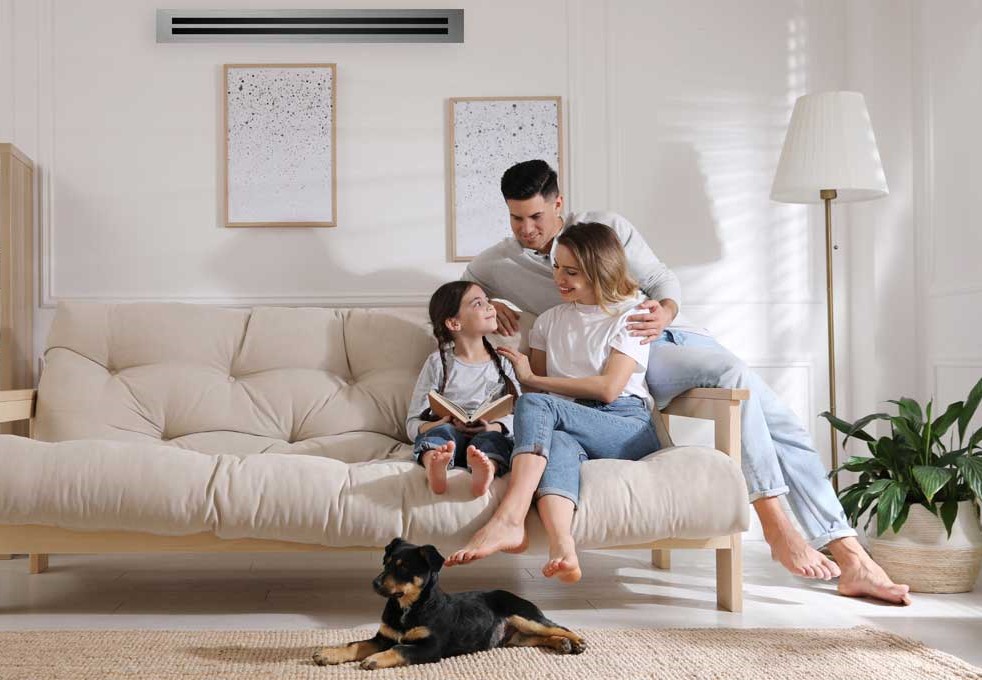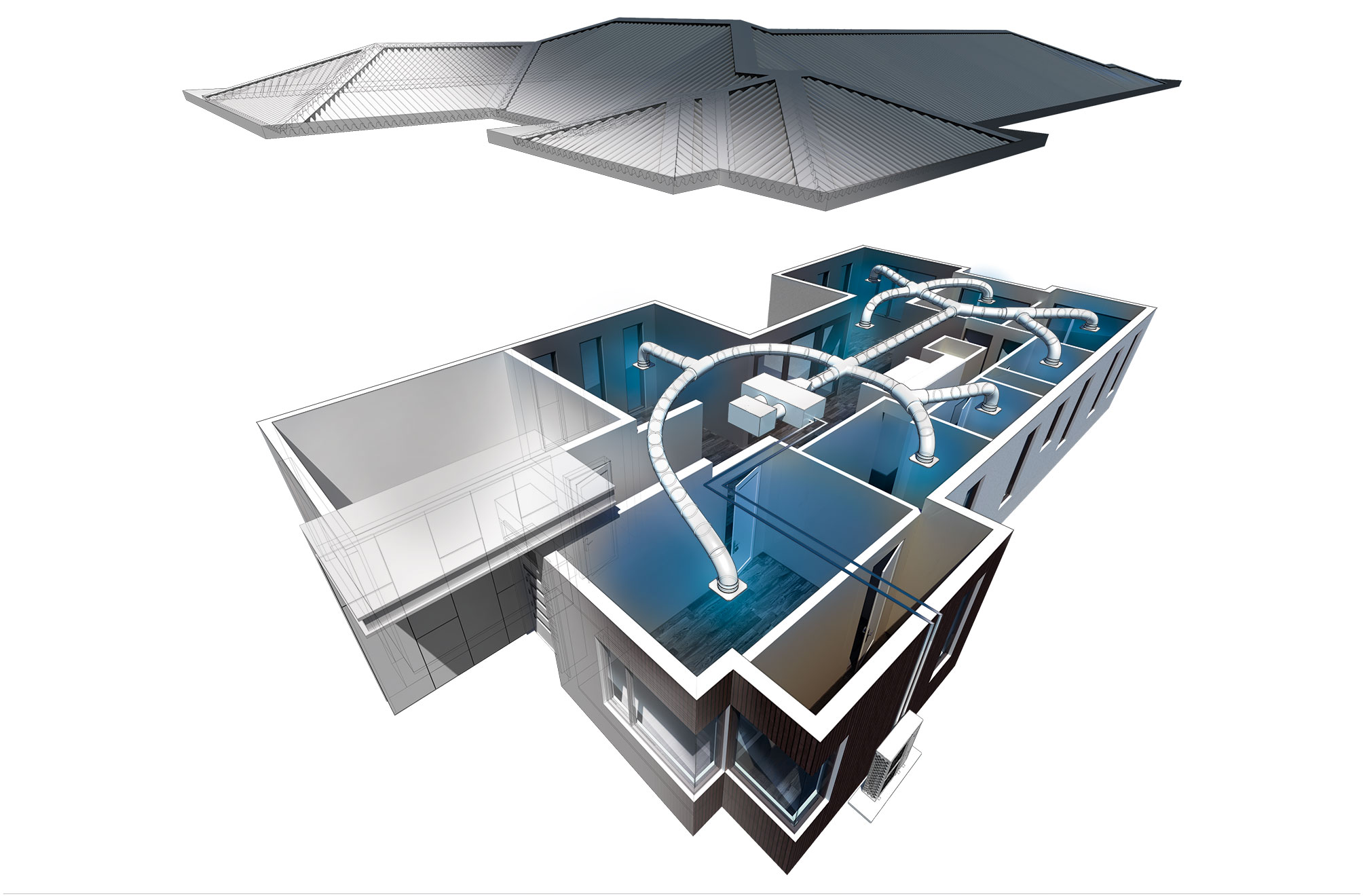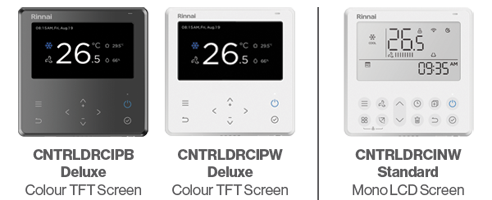Designed for New Zealand’s ever-changing climate, the Rinnai Pro Series Ducted Heat Pump System provides both optimal heating and cooling all year round – no matter where you live in the country.
Packed with innovative features including Wi-Fi connectivity, fast cool/heat function and sleep mode, the Pro Series Ducted Heat Pump is the ultimate in providing complete comfort. This smart system can also work around your unique lifestyle with an ultra-practical timer function, allowing you to set the unit’s operation times to achieve the perfect room temperature.
This energy-efficient heat pump is eligible for an NZ Green Energy Loan - read here for more information.
With stylish controller design options, the Rinnai Pro Series range is discreet, quiet and simple to use. The perfect way to heat or cool your home.

Need some help finding the perfect Heat Pump? Here's everything you need to know.
FIND OUT MOREUse our heat pump guide to help identify which of our heat pumps is right for your space.
Just complete our simple form to get a free, personalised quote from one of our nationwide Heat Pump dealers.
ENQUIRE NOW

Designed and Built for New Zealand Conditions
There’s no weather in the world quite like what we experience in New Zealand. This means when you design a Heat Pump System, you need one that can stand up to whatever Mother Nature throws at it.
With that in mind, the Rinnai Pro Series is designed especially for New Zealand. Through product design, durable build materials, and organic coatings, we have developed the Pro Series to better resist our harsh coastal environments where salt can have a devastating effect on lesser-designed products.
Particular thought has gone into our outdoor unit which includes stainless steel bolts, a clever case design to maximise water runoff, and a hermetically sealed electrical box, which all contribute to the increased overall durability of the series.
Pro-Pel Coil Protection
The Rinnai Pro Series indoor and outdoor coils are coated with our unique, non-toxic Pro-Pel Coil Protection making them more resistant to oxidation and corrosion. This 100% environmentally friendly coating delivers greater longevity and sustained performance in coastal areas and other harsh environments.
Additionally, the hydrophilic properties of Pro-Pel Coil Protection effectively reduce bacteria growth and improve the low-temperature heating efficiency of the Pro Series by accelerating the defrosting process.
![]()
|
Wall Mounted Programmable Controller & Thermostat |
|
 |
|
 |
Eco Cool When in cooling mode, with the press of a button your ducted system will enter a pre-programmed combination of settings which can reduce energy use by up to 60%. |
 |
Turbo Mode This function gives you a boost in cooling or heating power to more quickly achieve your desired room temperature. |
 |
Daily & Weekly Timer A convenient on and off timer for the next 24 hour period – programmable from your remote. Convenient weekly scheduling programmable via the wall controller or the NetHome Plus App. |
 |
Wi-Fi Control * The Rinnai Pro Series features Wi-Fi control via an easy-to-use App. With easy Bluetooth setup via the NetHome Plus App, it’s never been easier to control your Heat Pump from anywhere in the world. It allows full control with Alexa and Google Home including voice commands and a clever geolocation function to auto on/off when you arrive or leave home – the ultimate in convenience and comfort. |
| Active Clean Six-step self-cleaning at up to 56°C temperature deeply purifies the evaporator, providing a fresh and clean air supply. Recommended to run at the end of each season. |
|
 |
FreshFlow Air Inlet Remove stale air and save energy by introducing cool, filtered fresh air via the built-in FreshFlow Air Inlet. Requires additional duct installation, consult with your installer. |
 |
Dehumidifying Mode Take moisture out of the air when humidity gets high with this helpful feature. |
 |
Zoning The zoning of rooms is deliverable via third-party zone controllers. Compatible systems include MyAir, Airtouch and iZone. Discuss with your installer for more information. |
 |
|
* NetHome Plus is a third party application independent of Rinnai.
Wall mount controller plus Wi-Fi smartphone app
Detailed specification information is available on the last page of the customer brochure.
June 2023
Key considerations include: the size of the area you wish to heat or cool, if you want to heat or cool just one room or your entire home, the local climate, the number of windows in the area, insulation in the walls and possible location options.
For an electric heating and cooling solution, we recommend that you have an Accredited Heat Pump professional do a full assessment of your home and your comfort requirements to ensure you get the correct heat pump and sizing for your geographical location and unique requirements.
For more information, take a look at our ‘How to Choose the Right Heating & Cooling Solution for your Unique Space’ blog article.
Every home is as individual as its owner in its requirements and choosing the wrong size Heat Pump for the room you are wanting to heat can leave you cold and cost you more in power consumption.
Correctly determining the size of equipment for your space is critical and directly relates to how much energy or heat the unit can produce. An undersized unit will be ineffective in bringing a room to the desired temperature, while an oversized unit will turn off and on frequently, causing wear and tear.
Aspects to be considered include – the size of the room you wish to heat; how many doors and windows it has and how they are situated; is the room insulated - to name a few. Because of the technical nature of correct sizing, the key to selecting the right size Heat Pump for your home is an assessment and discussion of your needs with an accredited Heat Pump professional.
Typically, Heat Pumps are sized and installed to heat a single room or area. To heat your whole home, you may need several Heat Pumps, or a Ducted Heating & Cooling System. For more on Ducted Heat Pump Systems take a look at our 'What is a Ducted Heat Pump System' blog article.
Factors such as the energy efficiency of your particular unit, whether it is sized correctly for the area, your individual energy company rates and how effectively you use the unit will all be a consideration here.
EECA (The Energy Efficiency & Conservation Authority) has identified Heat Pumps as one of the most energy efficient forms of heating around. Heat Pumps do not create heat, they simply move available heat from one place to another. The little energy that is needed is predominantly used to run the compressor.
A Heat Pump typically uses 1kW to create 4kW of heat. The result is around 4 times less energy needed to that of traditional electric heaters, saving you money by reducing your power bill. Running your heat pump is roughly one quarter the cost of traditional electric heating and are one of the most cost-effective ways of keeping your home warm and dry.
Heat Pump servicing is often overlooked as an integral part of maintaining the longevity and efficiency of the unit.
It is recommended that you have your Heat Pump professionally serviced every 12 months, ideally before the start of winter, to ensure your unit is working optimally. Whilst DIY home maintenance will help keep your unit working effectively and efficiently, it does not replace the need to have your system professionally serviced by an accredited Heat Pump Air Conditioning technician.
A professional service will ensure your system will operate smoothly and efficiently delivering comfort to your home environment whilst extending the life of your investment. As a guideline, your Heat Pump should be serviced annually.
Experienced and qualified installers usually take somewhere around 3-4 hours for a straightforward back-to-back (where the indoor unit and outdoor unit are positioned directly opposite each other on the interior and exterior of a wall) Heat Pump installation. More complex Heat Pump installations will take a bit longer.
Ducted systems can take between one to two days depending on the amount of spaces to be ducted. Installing a Heat Pump is a complex process requiring qualified trade professionals so must ALWAYS be undertaken by a reputable accredited installation company.
Common sense tells us that no heating appliance should be used 24 hours a day. Using your heat pump correctly is using it as required.
If you are not home during the day, there is no need to run your heat pump during the day, adding to your power bills unnecessarily. If your home has good insulation, a couple of hours in the morning and a few hours in the evening should suffice.
We would advise running your Heat Pump somewhere between 18 and 22 degrees on heating in Winter. If you want to keep it on all night you can drop the temperature back to around 18 degrees – or use the ‘Sleep Function’ (Q Series feature) to take of it for you.
During the summer, you can run your Heat Pump on cooling at around 18 or 19 degrees, and if you wanted to run it all night you could increase the temp by a degree or two.
When the temperature drops, Heat Pumps perform a defrost cycle to remove ice build-up on the outdoor heat exchanger. Ice build-up occurs during the heat process as the outdoor unit takes the moisture and heat from the air.
The defrost cycle is a necessary part of the Heat Pump’s operation, as the airflow can be restricted if the heat exchanger is covered in ice, which will subsequently affect its efficiency. Ice also acts as a thermal insulation barrier on the heat exchanger preventing heat absorption. By defrosting the heat exchanger the unit’s efficiency increases.
In defrost mode the Heat Pump will stop heating for short periods of time and it’s important not to turn your system off when it’s going through this cycle.


This guide outlines the available loan options and the application process, helping you install a top-quality appliance for a warmer home and reliable hot water supply.
Read ArticleR290 refrigerant, (a.k.a propane) has gained attention for its environmental benefits compared to traditional refrigerants - and here's why.
Read ArticleIt's important to consider the impact of heating and cooling on our health. In this article, we'll dive into the world of heat pumps and explore how they affect your health and that of your family.
Read Article